Across cultures and centuries, epic poetry has preserved the larger-than-life figures who embody the ideals, conflicts, and spiritual yearnings of their civilizations. In Iran, Greece, and India, three such heroes stand out: Rostam of Ferdowsi’s Shahnameh, Achilles of Homer’s Iliad, and Arjuna of Vyasa’s Mahabharata. Though separated by geography and worldview, these warriors share fascinating similarities—and striking contrasts.
Let’s explore how these legendary figures reflect the values of their cultures, and what makes each of them an enduring symbol of heroism.
1. Rostam: The Loyal Champion of Persia
Source: Shahnameh (Book of Kings) by Ferdowsi
Role: Defender of the Iranian throne and nation
Core Traits: Strength, loyalty, honor, fatalism
Rostam, the mighty paladin of the Persian Shahnameh, is a hero of unmatched physical prowess and battlefield courage. Mounted on his famed steed Rakhsh, he single-handedly defeats dragons, demons, and entire armies. But his greatness lies not just in combat—it is in his loyalty to the crown, even when it costs him personally.
Tragically, this same loyalty leads to heartbreak. In the tale of Sohrab, Rostam unknowingly kills his own son in battle, a moment that reflects the Shahnameh’s deep concern with fate, miscommunication, and the tragic cost of honor-bound duty.
Key Themes:
-
The tension between individual grief and national loyalty
-
The burden of fate and irreversible choices
-
Heroism tied to self-restraint and duty
2. Achilles: The Wrathful Hero of Greece
Source: Iliad by Homer
Role: Supreme Greek warrior at Troy
Core Traits: Pride, glory, rage, mortality
Achilles, the central figure of Homer’s Iliad, is a warrior of divine origin and terrifying power. Yet he is most remembered not for his victories, but for his rage. When his pride is wounded, he withdraws from battle—causing countless Greek deaths. Only the death of his beloved friend Patroclus moves him to return, in a path of vengeance that culminates in the slaying of Hector.
Achilles is the ultimate Greek hero: driven by honor and personal glory, yet haunted by mortality. He knows his fate—early death in exchange for eternal fame—and accepts it with tragic awareness.
Key Themes:
-
Glory versus life: the heroic dilemma
-
The destructive nature of rage
-
The fragile boundary between man and god
3. Arjuna: The Warrior of Dharma
Source: Mahabharata by Vyasa (especially the Bhagavad Gita)
Role: Archer and prince of the Pandavas
Core Traits: Doubt, introspection, righteousness, spiritual awakening
Arjuna is arguably the most reflective of the three heroes. On the eve of battle at Kurukshetra, he lays down his weapons, overcome by sorrow and confusion. The epic pauses for the Bhagavad Gita, where Krishna—his charioteer and the incarnation of the divine—urges him to fulfill his duty (dharma) as a warrior.
Unlike Rostam or Achilles, Arjuna’s heroism is less about sheer physical might and more about moral clarity and spiritual alignment. His quest is not only outward, but inward—seeking unity with the eternal through action free of attachment.
Key Themes:
-
The balance between duty and conscience
-
Action aligned with cosmic order (dharma)
-
The inner battle as crucial as the outer one
Heroic Similarities: Shared Myths, Shared Humanity
Despite their cultural differences, Rostam, Achilles, and Arjuna share many archetypal elements:
-
Divine Connection: Each is semi-divine or aided by divine forces (Rostam by Zal and Simurgh, Achilles by Thetis, Arjuna by Krishna).
-
Moral Conflict: All face dilemmas that challenge not just their might, but their values and identity.
-
Tragic Weight: Each carries the burden of fate, loss, or inner turmoil, highlighting the limits of human agency in the face of destiny.
Contrasts: What Their Cultures Emphasize
-
Rostam reflects Persian values of loyalty and the tragic hero, burdened by fate and service to a greater cause.
-
Achilles embodies the Greek heroic ideal of individual glory, even at the cost of others or himself.
-
Arjuna represents Indian spiritual philosophy, where victory is meaningless without alignment with dharma and cosmic truth.
Final Thoughts: The Hero’s Journey, Reimagined
These three figures—Rostam, Achilles, and Arjuna—continue to inspire not because they are perfect, but because they are flawed, human, and deeply symbolic. Each offers a different vision of what it means to be heroic: the tragic champion, the glorious avenger, the enlightened warrior.
And in their stories, we find not only echoes of their times—but timeless questions about who we are, what we fight for, and how we face the trials of life.
Which epic hero resonates most with you—and why? Share your thoughts and let's discuss how ancient stories still shape our understanding of courage, duty, and destiny.





